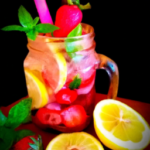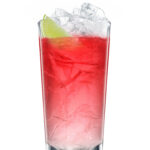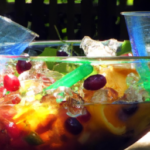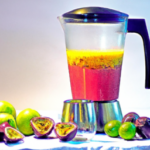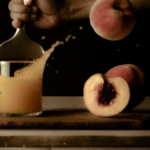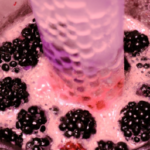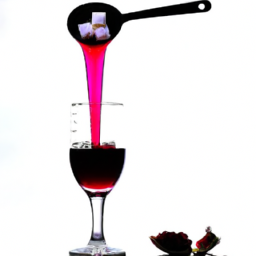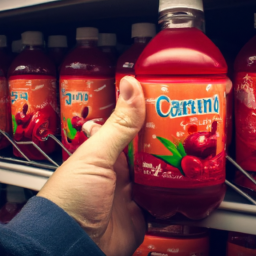Have you ever been to a summer camp or a backyard BBQ where ‘bug juice’ was served?
If you have, then you know that this sweet, fruity drink is a staple of warm-weather gatherings. But did you know that you can make it at home? It’s true! With just a few simple ingredients and some basic kitchen equipment, you can whip up a batch of bug juice that will rival anything you’ve ever tasted before.
I first learned how to make bug juice when I was a counselor at a summer camp. We would mix up a big batch every day and serve it to the kids with lunch and dinner. They loved it so much that they would often ask for seconds and thirds!
Now that I’m an adult, I still make bug juice whenever I have friends over for a backyard barbecue or a pool party. It’s the perfect way to cool off on a hot day, and it’s always a hit with my guests.
So, if you’re ready to learn how to make bug juice, let’s get started!
Key Takeaways
- Bug juice is a popular drink at summer camps and barbecues, and can be easily made at home with a few ingredients and equipment.
- Adding fresh, ripe fruits not only enhances the flavor of bug juice but also provides important nutrients that can boost the immune system and improve digestion.
- It is recommended to adjust the sweetness and sourness of bug juice to create different flavors, and to experiment with variations and flavor profiles using herbs and spices.
- Leftover bug juice can be stored for later use and repurposed for popsicles, smoothies, or ice cubes.
Gather Your Ingredients
Let’s grab all the ingredients we need to whip up some tasty bug juice! First, you’ll need to decide on your flavor combinations. Some popular options include citrusy lemon and lime, sweet strawberry and raspberry, or tangy orange and grapefruit. You can also experiment with different fruit and herb combinations to find your perfect blend. However, keep in mind that some fruits and herbs may overpower the taste of your bug juice, so it’s best to start with small amounts and adjust as needed.
Next, gather your ingredients. For a basic bug juice recipe, you’ll need water, sugar, and a variety of fruits and herbs. However, ingredient substitutions are always an option if you prefer a healthier or more unique recipe. For example, you can use honey or agave syrup instead of sugar, or add vegetables like carrots and beets for added nutrients. Whatever ingredients you choose, make sure they are fresh and ripe for the best flavor.
Now that we have our ingredients, let’s get our equipment ready.
Get Your Equipment Ready
Before we start mixing our bug juice, it’s important to have the right equipment ready.
First, I’ll need a large pitcher to mix all the ingredients together.
I’ll also need to select a mixing spoon that’s sturdy enough to stir everything thoroughly.
Finally, I’ll need to prepare glasses or cups to serve the bug juice in.
Having the right equipment prepared will make the process much smoother and ensure that the bug juice is mixed thoroughly.
Find a Large Pitcher
To make bug juice, you’ll need a large pitcher. Pitcher size is important because bug juice is typically made in large batches, and you don’t want to have to keep refilling a small container. Look for a container that can hold at least one gallon of liquid.
A gallon-sized mason jar or a plastic pitcher would work well. Pitcher material is also important. You want a container that won’t leak or break easily. Glass pitchers are sturdy and look nice, but they can be heavy and breakable. Plastic pitchers are lightweight and durable, but they may not look as nice as glass.
When I made bug juice for a backyard party, I used a large glass pitcher that I found at a thrift store. It was perfect because it was big enough to hold a gallon of liquid and it looked nice on the table.
Once you have your pitcher, it’s time to select a mixing spoon.
Select a Mixing Spoon
Now it’s important to choose a mixing spoon that will work well with your pitcher. When it comes to selecting a spoon for bug juice mixing, the first thing to consider is the material. You can choose either a metal or a plastic spoon.
Metal spoons are generally more durable and can be used for a longer time without breaking down. On the other hand, plastic spoons are lightweight and easier to handle. Another factor to consider is the shape of the spoon. The shape of the spoon can greatly affect the mixing process.
A spoon with a long handle can help you reach the bottom of the pitcher and mix the bug juice evenly. A spoon with a flat end can also be useful in scraping the bottom of the pitcher. Lastly, a spoon with a rounded tip can help you scoop the ingredients and mix them well.
With the right spoon, you can easily create a delicious bug juice that everyone will love. Now that you have your pitcher and spoon ready, it’s time to prepare glasses or cups for serving.
Prepare Glasses or Cups
As you’re getting ready to serve your refreshing bug juice, don’t forget to prep your glasses or cups. You want to make sure that the presentation of your drink is just as impressive as the taste. Using creative serving ideas can make your bug juice stand out and be the talk of the party.
For example, you could use mason jars with striped paper straws or even rim your glasses with sugar or salt for added flavor and texture. There are many alternatives to traditional glasses, such as using mini fishbowls or test tubes for a more unique and creative look.
When serving bug juice, it’s important to make sure that each glass or cup is clean and free of any residue or debris. To do this, simply wash them with hot, soapy water and rinse thoroughly. You can also chill your glasses or cups in the freezer for a few minutes before serving to keep your bug juice cold and refreshing.
With your glasses or cups prepped and ready to go, it’s time to mix the juices and create your delicious bug juice concoction.
Mix the Juices
Next, I pour the cranberry and pineapple juices into a large mixing bowl. The juice combinations are important to consider when making bug juice, as you want to create a delicious and refreshing flavor that will mask the taste of any added supplements.
Additionally, flavor preferences should be taken into account, as some people may prefer a sweeter or tangier taste. Once the juices are in the bowl, I use a whisk to mix them together thoroughly. It’s important to make sure that the juices are well combined to ensure that the flavors are evenly distributed.
After mixing, I transition into the subsequent section about adding the soda, which will add a fizzy element to the bug juice and make it even more refreshing.
Add the Soda
To add some fizz to your refreshing drink, you’ll need to pour in the soda. Did you know that Americans consume over 17 billion gallons of carbonated soft drinks each year? Here are some tips for adding soda to your Bug Juice:
-
Alternative sodas for Bug Juice: If you’re looking for a healthier option, try using sparkling water or flavored seltzer instead of traditional soda. These options have less sugar and fewer calories, making them a great choice for those who want to enjoy Bug Juice without consuming too much sugar.
-
How to make Bug Juice without soda: If you don’t have soda on hand or if you want to avoid it altogether, you can still make delicious Bug Juice. Simply mix together your choice of juices and add a splash of sparkling water or seltzer for a little bit of fizz.
-
When to add the soda: Wait until just before serving to add the soda to your Bug Juice. This will help to keep the bubbles from going flat too quickly, ensuring that your drink stays fizzy and refreshing.
-
How much soda to add: The amount of soda you add to your Bug Juice will depend on your personal preference. Start with a small amount and gradually add more until you achieve the level of fizziness that you desire.
To make your Bug Juice even more delicious, consider adding fresh fruit (optional).
Add Fresh Fruit (Optional)
I prefer to add fresh fruit to my bug juice to give it a more natural flavor. To do this, I choose my favorite fruits such as strawberries, blueberries, and watermelon.
After washing and cutting the fruits into small pieces, I add them to the pitcher. This not only adds flavor but also adds important vitamins and nutrients to the drink.
Choose Your Favorite Fruits
Selecting your preferred fruits is a crucial step in crafting a delicious batch of bug juice. Not only do fruits add flavor to the drink, but they also provide essential nutrients that are beneficial to our health. Fruits are packed with vitamins, minerals, fiber, and antioxidants that help boost our immune system, improve digestion, and protect our body against diseases.
When choosing your fruits, it’s important to select those that are ripe and in season. Ripe fruits are sweeter and more flavorful, making them a great addition to the bug juice. You can check if a fruit is ripe by smelling it, feeling its texture, and checking for any spots or bruises. Here’s a table that can help you choose the perfect fruits for your bug juice:
| Fruit | Benefits | Season |
|---|---|---|
| Strawberries | Rich in vitamin C and antioxidants | Spring and summer |
| Blueberries | Packed with fiber and anti-inflammatory properties | Summer |
| Mangoes | High in vitamin A and potassium | Summer |
| Pineapples | Contains digestive enzymes and anti-inflammatory properties | Summer |
| Kiwis | Rich in vitamin C and fiber | Fall and winter |
| Pomegranates | Loaded with antioxidants and anti-inflammatory properties | Fall and winter |
Once you’ve selected your fruits, it’s time to wash and cut them into small pieces to prepare them for the next step.
Wash and Cut into Small Pieces
After you’ve chosen your favorite fruits, the next step in making bug juice is to wash and cut them into small pieces. This might seem like a simple task, but it’s important to do it correctly to ensure that your bug juice is both delicious and safe to drink.
Firstly, it’s important to practice knife safety when cutting your fruit. Always use a sharp knife and keep your fingers away from the blade. Additionally, make sure to select ripe fruit, as it’ll be easier to cut and will add more flavor to your bug juice.
Once you have your fruit, rinse it under cold water and dry it with a clean towel. Then, using a cutting board and a sharp knife, cut the fruit into small, bite-sized pieces. This will make it easier to blend and will ensure that your bug juice has a smooth consistency.
Now that your fruit is washed and cut, it’s time to add it to the pitcher. But before we do that, let’s take a moment to talk about the importance of selecting the right pitcher for your bug juice.
Add to the Pitcher
Now that your fruits are chopped into delectable bits, it’s time to toss them into the pitcher and watch as the flavors dance together in a fruity frenzy.
Before adding any liquid, it’s beneficial to include a few ice cubes to keep the mixture cool and refreshing. The benefits of adding ice go beyond just temperature control; it also helps to dilute any overpowering flavors and ensures a smoother consistency. Using crushed ice instead of whole cubes can further enhance this effect, allowing the fruits to release their flavors even more.
As you stir the mixture, consider alternatives to the traditional mixing spoon. A wooden spoon or muddler can help to break down the fruit even further, releasing more juice and flavor. Alternatively, a blender or food processor can be used to create a smoother texture.
Whatever method you choose, be sure to thoroughly mix the fruits together to create a harmonious blend of flavors.
With the fruit chopped, the ice added, and the mixture stirred, it’s time to chill the bug juice and allow the flavors to meld together even more.
Chill the Bug Juice
To keep your Bug Juice refreshing, throw it in the fridge for a bit before serving. Chilling your drink not only enhances its taste but also has several benefits.
Here are some tips for keeping drinks cold during outdoor activities:
- Use a cooler or ice bucket to store your drinks.
- Freeze your drinks before heading out, and they’ll stay chilled for longer.
- Wrap your drinks in a wet towel and place them in the shade. As the water evaporates, it will cool the drinks down.
- If you’re in a rush, add some salt to your ice water. This will lower the freezing point of the water, causing it to become colder.
By following these tips, you’ll be able to enjoy a chilled and refreshing glass of Bug Juice even during the hottest summer days. Remember to stir before serving to ensure that all the flavors are evenly distributed.
Stir Before Serving
Before serving the bug juice, it’s important to mix all the ingredients thoroughly to ensure that the flavors are well blended. I usually use a spoon or a whisk to stir the mixture until it’s smooth and all the sugar has dissolved.
Once the bug juice is mixed, it can be poured into glasses or cups, and ice can be added if desired for a refreshing and cool beverage.
Mix the Ingredients
First, grab a pitcher and start tossing in the sliced fruit and berries, allowing them to release their sweet juices and create a colorful, vibrant mixture that’ll make your taste buds dance with delight.
Next, add in the water, sugar, and lemon juice, and give it a good stir until the sugar dissolves completely. Here’re some ingredient substitutions and flavor combinations you may wanna try:
- Substitute water with sparkling water for a fizzy bug juice
- Try using honey instead of sugar for a more natural sweetness
- Add in some fresh herbs like mint or basil for a refreshing twist
- Mix different fruits and berries together for a unique flavor profile
- Experiment with different citrus juices like lime or grapefruit for a tangy kick
Once all of the ingredients are mixed together, let the bug juice sit in the fridge for at least an hour to allow the flavors to meld together. Trust me, it’ll be worth the wait!
Now that the bug juice is ready, it’s time to pour it into glasses or cups and serve it cold.
Pour into Glasses or Cups
Now it’s time to quench your thirst and pour the delicious fruit-infused mixture into glasses or cups, so you can enjoy its refreshing taste and beautiful colors. To do this, simply take a ladle or a measuring cup and carefully pour the bug juice into glasses or cups. Be sure to leave some room at the top for ice and any creative garnish you may want to add.
Speaking of creative serving ideas, there are endless options to make your bug juice stand out! You can use mason jars for a rustic feel, or stemless wine glasses for a more elegant touch. For fun garnish options, try adding a slice of fresh fruit or a sprig of mint to each cup. These little additions not only add a pop of color but also enhance the flavor of the bug juice. And don’t forget, adding ice is optional, but highly recommended for an extra refreshing sip.
Now, let’s move on to the next section where we will talk about adding ice (optional) to your bug juice.
Add Ice (Optional)
You can enhance the refreshment factor of your bug juice by adding some ice cubes. Not only will it cool down your beverage on hot summer days, but it will also add a nice touch to the overall presentation. If you don’t have ice cubes, you can try using frozen fruit or berries as ice alternatives. This will not only chill your drink but also infuse it with a fruity taste.
When it comes to serving your bug juice with ice, there are a few things to keep in mind. First, make sure that your glass or cup is big enough to accommodate both the liquid and the ice. Second, don’t add too much ice, or you’ll end up with a watered-down drink.
Finally, if you want to take your bug juice to the next level, you can try adding some fresh herbs like mint or basil for an extra burst of flavor. With your bug juice chilled and ready to go, it’s time to enjoy!
Enjoy Your Bug Juice
To truly savor your bug juice, take a moment to appreciate the unique blend of flavors and embrace the adventurous spirit it represents. As we know, bug juice is made with a variety of fruit juices and sweeteners, but the addition of insects brings an entirely new dimension to the drink.
Not only does it add a protein boost, but it also introduces a savory and slightly earthy taste that complements the sweetness of the juice. Aside from its distinctive flavor, bug juice also boasts several health benefits.
Insects are a great source of protein, vitamins, and minerals, making bug juice a nutritious addition to any diet. Additionally, the use of insects in food is becoming increasingly popular as a sustainable and eco-friendly alternative to traditional protein sources.
For those looking to get creative with their bug juice, there are endless possibilities for experimenting with different fruit and insect combinations. From mango and cricket juice to raspberry and mealworm juice, the sky’s the limit when it comes to bug juice recipes.
Now that you’ve enjoyed your bug juice, it’s important to store any leftovers properly to ensure freshness and prevent spoilage. One option is to refrigerate the bug juice in an airtight container, which will keep it fresh for up to a week. Alternatively, you can freeze the juice in ice cube trays and use them as a flavorful addition to smoothies or other drinks.
No matter how you choose to store it, be sure to enjoy your bug juice within a reasonable timeframe to ensure the best taste and quality.
Store Leftovers
After savoring the unique blend of flavors in your insect-infused fruit drink, make sure to properly store any leftovers to ensure freshness and prevent spoilage.
To do this, transfer the remaining bug juice into an airtight container and immediately refrigerate it. This will preserve the drink’s quality and prevent bacterial growth that can cause spoilage.
If you find yourself with excess bug juice that you won’t be able to consume within a few days, get creative and repurpose the leftovers to reduce food waste. Use it as a base for popsicles or smoothies, or freeze it into ice cubes for a refreshing addition to water or other beverages.
With your leftovers safely stored, you can now experiment with variations of the recipe.
Experiment with Variations
After storing the leftovers of my last batch of bug juice, I decided to experiment with some variations for my next batch. I wanted to explore the different flavor profiles that I could create by adjusting the sweetness or sourness, as well as incorporating different fruity or floral flavors.
Here are some of my findings:
-
Sweet vs Sour: By adjusting the amount of sugar or lemon juice in the recipe, I found that I could create a sweeter or more sour bug juice. For a sweeter juice, I added more sugar and less lemon juice, while for a more sour juice, I added less sugar and more lemon juice.
-
Fruity vs Floral: I also experimented with adding different fruits and flowers to the recipe to create unique flavor combinations. For a fruity bug juice, I added strawberries and raspberries, while for a floral bug juice, I added lavender and chamomile.
Overall, I found that experimenting with variations was a fun and creative way to make bug juice. By adjusting the sweetness, sourness, and incorporating different fruits and flowers, I was able to create unique and delicious flavors. I also discovered that herbs and spices can add depth and complexity to the taste of my bug juice.
In my next batch, I plan to use cinnamon and ginger to create a warm and spicy bug juice flavor.
Frequently Asked Questions
What are some common variations of bug juice that people like to experiment with?
Oh, the endless possibilities of bug juice! Flavor combinations like crushed beetles with lemonade or dried crickets with strawberry syrup. Presentation ideas like adding gummy worms or using a syringe to squirt the mixture into cups. The science of it all is truly fascinating.
How long does bug juice typically last in the refrigerator?
The shelf life of bug juice varies depending on the ingredients used. To extend its shelf life, store it in an airtight container in the refrigerator. Experiment with different flavor combinations and conduct taste testing to determine your preferred mix.
Can bug juice be made without soda?
Yes, bug juice can be made without soda. Alternative ingredients that can be used include fruit juices, sparkling water, or kombucha. However, it’s important to note that some fruit juices can contain added sugars and potential health risks.
What type of fruit works best in bug juice?
What type of fruit works best in bug juice? Experimenting with fruit combinations can lead to unique flavors and alternatives to soda. Consider using citrus, berries, or tropical fruits for a refreshing twist.
Are there any health benefits to drinking bug juice?
Bug juice offers health benefits such as antioxidants, vitamins, and fiber. Compared to other health drinks, it’s a natural alternative with fewer added sugars and preservatives. Its unique blend of fruits also provides a range of nutrients.
Conclusion
In conclusion, making bug juice is a fun and refreshing activity that anyone can enjoy. With just a few simple ingredients and some basic equipment, you can create a delicious and healthy beverage that is perfect for any occasion.
One interesting statistic to consider is that the average American consumes over 50 gallons of soda per year. This is a staggering amount of sugary and unhealthy drinks that can have a negative impact on your health. By learning how to make bug juice, you can not only enjoy a delicious beverage, but also make a healthier choice for yourself and your family.
With so many variations and options to choose from, there’s no reason not to give bug juice a try today!
Ilana has been a vegan for over 10 years. She originally made the switch for health reasons, but soon found herself becoming more and more passionate about the ethical and environmental implications of a vegan lifestyle. Ilana is the author of The Graceful Kitchen, a blog all about veganism. She loves to cook up delicious and nutritious vegan meals, and share her recipes with others who are interested in leading a cruelty-free life. Ilana is also a strong advocate for using whole foods as the foundation of a healthy diet, and believes that going vegan is one of the best ways to achieve this.



